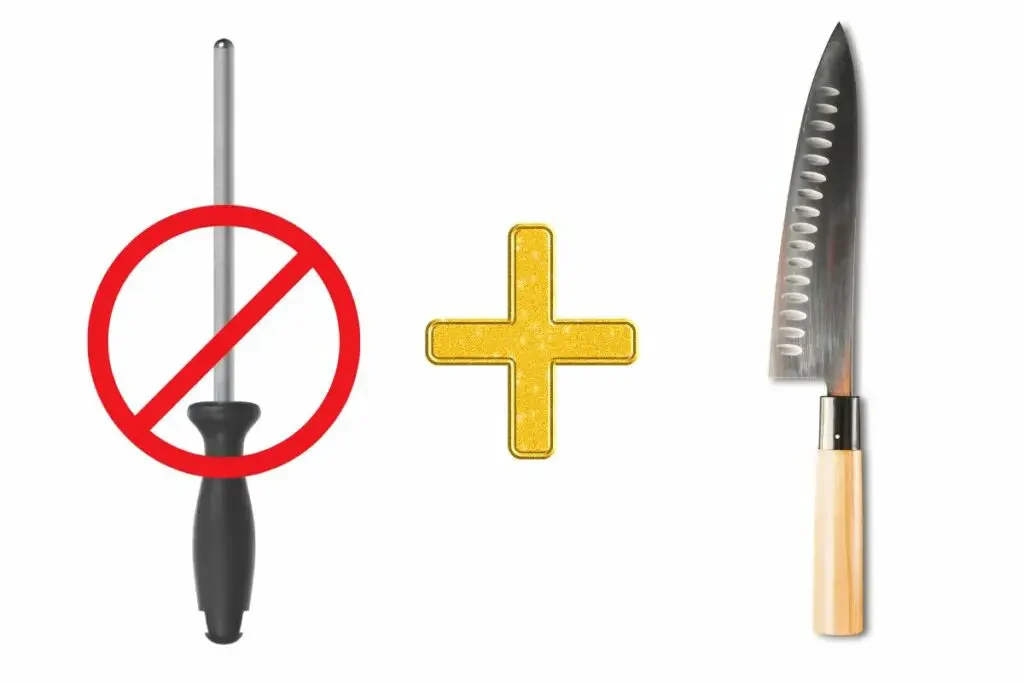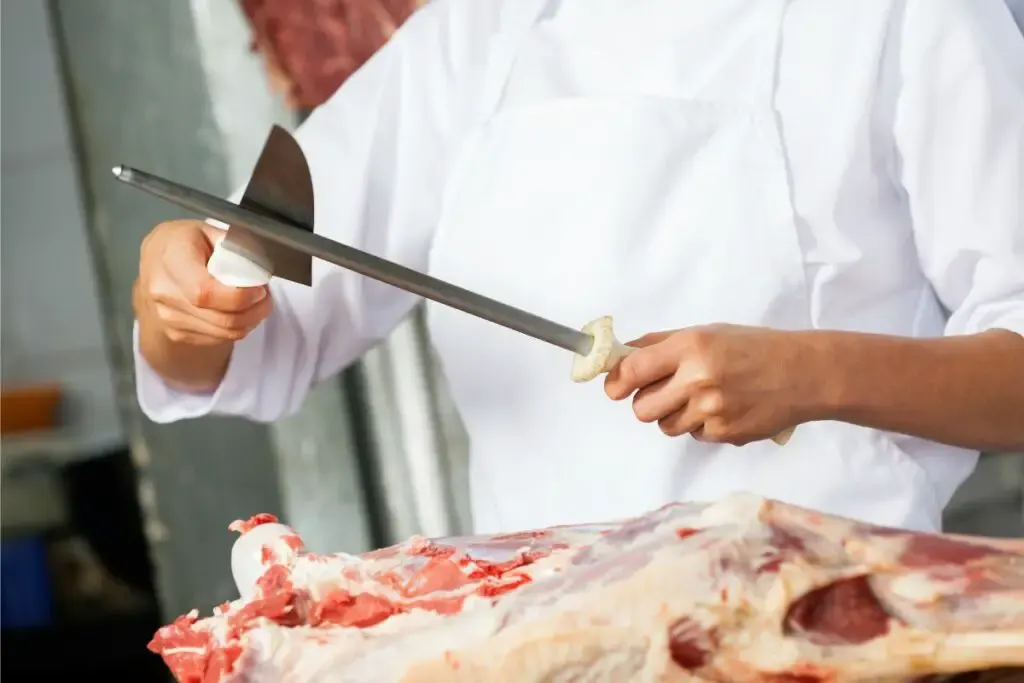As an Amazon Associate, we earn from qualifying purchases with no additional costs for you.
f you are an owner of a set of Japanese knives, you would want to take the best care of them that you can. Mostly when you see a Japanese knife being sharpened, it is on a whetstone of some sort. You may wonder if sharpening steel has any place being used on a Japanese knife or if this is not a recommended practice. So, can you sharpen a Japanese knife with steel?
You should never use steel on a high-carbon steel Japanese knife. The steel on these knives is harder and more brittle than other steels, and the flexing of the edge from the sharpening steel will cause the edge of the knife to crack and break off, and you will have chips in the edge of the knife.
A sharpening steel is often seen being used to hone the edge of a kitchen knife, and the knife is then sharp once again and ready to be used. This process may work on some kitchen knives that are made from certain steel, but when it comes to traditional Japanese kitchen knives, sharpening steel is not a good option to restore the edge.
If you are interested in checking out the best whetstones for your knives we recommend and use you can find them by clicking here (Amazon link).

Why You Shouldn’t Use A Steel On A Japanese Knife
You will see sharpening steel, or honing steel in many kitchens, even in a commercial kitchen that has Japanese knives. So, why is steel so bad for using on a Japanese knife?
The reason why sharpening steel is not a good idea for a Japanese knife pertains to what honing steel does to a knife and the type of steel and structure of a Japanese knife.
What Does A Sharpening Steel Do?
When a kitchen knife is used, they sometimes lose some of their sharpness as natural wear and tear from use.
The loss of sharpness of the knife is a result of the thin cutting edge of the knife rolling over to one side slightly or becoming misaligned from the centerline. This makes the edge lose some of its cutting efficiency, and the knife will feel slightly dull when used.
Honing steel or sharpening steel does not actually remove any material from the knife as the sharpening process does.
The honing steel simply bends the thin edge back into alignment with the centerline of the knife, and the edge will then pass through the food smoothly and without resistance from an edge that is misaligned.
Why Are Steels Bad For Japanese Knives?

So, if steel realigns a knife-edge and the knife is sharp again after the process, why are they so bad for a Japanese knife?
The explanation for this comes from the steel used to make Japanese knives and the construction geometry of the blade.
Japanese knives are very thin, very sharp knives, and the only way the edge on a thin knife can be maintained is if the steel is harder than those used on other, thicker knives.
Most Japanese knives are made from high carbon steel. The hardness of the high-carbon steel is adjusted during the heat treatment and tempering cycles to produce harder steel. The downside of the harder steel is that it is not as flexible as other steel and is more brittle than other steel.
The harder steel does not bend easily and is more prone to chipping and breaking than softer steel which will have a more flexible edge.
The main function of sharpening steel is to bend the sharp edge of the knife back into alignment. When sharpening steel is used on a hard-steel Japanese knife, the bending of the edge fatigues the brittle steel, and instead of bending back into alignment, the piece of the edge breaks off.
Therefore, using steel on the edge of a Japanese kitchen knife will result in pieces of the thin, sharp edge chipping and breaking off due to the stress being placed on the brittle steel by the sharpening steel.
TIP: The process of honing is different from sharpening a knife. What method of honing is most beneficial and appropriate to use on a Japanese kitchen knife? Find out more in the article below:
Should You Hone Your Japanese Knives? You Should Know This
Are All Steels Bad For Japanese Knives?
There are various types of sharpening or honing steels, including steel butcher-style honing rods and ceramic or glass honing rods.
All of these honing tools, whether they are the steel kind with metal grooves or fine ceramic rods, all perform the same action on the edge of the knife blade.
All these tools act by bending the edge back into alignment, and it is this action that is so detrimental to the brittle, high-carbon steel edge on a Japanese knife.
This means that all honing rods, no matter what they are made from, should never be used to hone the edge of a Japanese high-carbon steel knife.
Some Japanese knife owners will use ceramic or glass honing rods on their Japanese knives and only perform light passes of the knife over the rod.
This may work, but it is a risky business since applying the slightest amount of too much pressure will damage the edge of the knife. So unless you know what you are doing, this method is not recommended.
Are Steels Bad For All Kitchen Knives?

Steels, be they ceramic, glass, or actual steels, are not bad for all kitchen knives. Many of the knives that are made in Germany, Switzerland, and France are not as hard as the Japanese knives.
These knives made in the west are not as thin as their Japanese counterparts, and therefore the steel is not taken to the same level of hardness.
This means that the fine, sharp edge on the knife is more flexible than that of the Japanese knives, and as such, steel can be used on these knives to realign the edge.
Not all Japanese-style kitchen knives are made from high-carbon steel. There are some brands, like Shun in particular, that make their knives from stainless steel.
Stainless steel is made from high-carbon steel, but it has chromium added to the allow to give the steel its stainless qualities.
The chromium also makes the steel more flexible, and the steel cannot be hardened to the same level as steel without the added chromium.
For this reason, you can use steel on a stainless-steel Japanese-style kitchen knife, but it is recommended that you use the ceramic-type sharpening rod rather than the steel variety.
TIP: Do you know how to properly sharpen a knife with a whetstone? Check out the ultimate guide in the article below:
Step-By-Step GUIDE: How To Sharpen A Knife With A Whetstone
What Should You Use Instead To Hone Your Japanese Knife?
If you should not be using honing steel to keep your Japanese kitchen knives in tip-top shape, what should you be using as an alternative?
The recommended alternatives to keep the edge in good working order are a finishing stone or a leather strop. The one that you choose will be determined by the method you feel most comfortable using, but the most common choice is the finishing stone.
A finishing stone is a very high gritstone that almost polishes the edge and will help to remove imperfections in the edge.
Because a finishing stone is a stone, it will remove material from the edge, but this will be a minuscule amount because of the fine grit of the stone.
A finishing stone will normally be a fine-grit stone with a coarseness in excess of 6000 grit. Stones of 12000-grit or more are great as a finishing stone for Japanese knives and will put a mirror finish on the edge, making them razor-sharp.
A leather strop is another option that some people use to keep their Japanese knives maintained. The leather strop is often coated with a fine jeweler’s rouge. The rouge is an abrasive that is similar in grit to a fine-grained finishing stone and will serve the same purpose and produce a mirror finish on the edge.
Leather is great for hard-edged knives because the leather is flexible and will not place a lot of pressure on the edge of the blade. This will prevent the flexing and resultant breaking of the brittle edge on your Japanese knife.
TIP: Are you looking to buy a new whetstone? Check out our recommendations (we personally use the first three ones):
Our PRO choice whetstones combo (Amazon links):
- Fixing stone: Whetstone SHAPTON Ceramic KUROMAKU #320
- Sharpening stone: Suehiro CERAX soaking whetstone: Medium #1000
- Finishing stone: Whetstone SHAPTON Ceramic KUROMAKU #5000
Our budget choice (Amazon link): Sharp Pebble Extra Large Sharpening Stone Set
FAQs For Sharpening Japanese Kitchen Knives
We have included some additional frequently asked questions regarding sharping Japanese kitchen knives to give you a broader perspective of this topic.
1. How Often Should I Sharpen My Japanese Knife?
The frequency of sharpening depends on how often you use your knife and what you use it for. However, a good rule of thumb is to sharpen your knife whenever it starts to feel dull or doesn’t cut as efficiently as it used to. Always remember to use a proper sharpening tool, like a finishing stone, to maintain the quality of your knife.
2. Can All Japanese Knives Be Sharpened?
Yes, all Japanese knives can be sharpened. However, the type of sharpener you should use can vary depending on the knife. For example, knives made from harder steel, like many Japanese knives, should not be honed with a steel rod as it can cause the edge to chip or break. Instead, use a finishing stone or leather strop.
3. What Are The Signs That My Japanese Knife Needs Sharpening?
If your knife is not cutting as efficiently as it used to, or if it’s tearing or crushing food instead of slicing through it cleanly, it’s likely time to sharpen your knife. Another test is to see if the knife can slice through a sheet of paper or a ripe tomato without effort.
4. Can I Use A Pull-Through Sharpener On My Japanese Knife?
Pull-through sharpeners are not recommended for high-quality Japanese knives. These sharpeners can be too aggressive and remove more metal than necessary, potentially damaging the knife. They also don’t provide the level of control that a finishing stone does. For Japanese knives, it’s best to use a finishing stone or leather strop.
Conclusion
Japanese kitchen knives are not cheap to buy, so if you are lucky enough to own one, or even a set, then you should take the best care of the knives as you can.
This includes using the most appropriate methods to keep the edge of the knife in optimum condition. For the relatively hard and brittle edge on these high-carbon steel knives, sharpening steel will do more damage than good.
The high price of these knives makes it not even worthwhile to even try these steels on the edge of your knife. Rather choose a better, more appropriate alternative such as a finishing stone or a leather strop to maintain the edge on your Japanese knives.
TIP: Japanese knives are quite expensive so it is good to know how to take care of them. Check out the complete guide on how to care for Japanese knives in the article below:
How To Care For Japanese Knives: The Complete Guide
